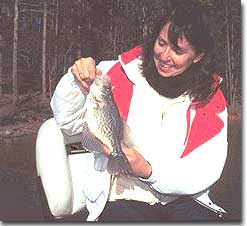Warm Days have Crappie on the Move
Warm Days have Crappie on the Move
By Bill Vanderford
Warm fronts with their southerly breezes will soon trigger a positive response from the crappie population, which is one of the most popular and sought after fish in Georgia. Availability in great numbers, a readiness to feed, and excellent table quality are the reasons for this panfish's popularity. In fact, the crappie is probably one of the easiest fish to understand and catch. Nevertheless, additional knowledge of the crappie's movements and habits assure an angler full stringers of these tasty members of the sunfish family.
 Major movement of crappies up into the rivers or feeder creeks of any reservoir begins when the water temperature rises and remains above 50 degrees. During most of the spring, crappies will congregate in underwater brush, blown-down trees, aquatic plant growths, or irregular rock formations along channel breaks near the mouths of feeder creeks or long coves off of the main river channels. The best coves or creeks are those that contain plenty of brush or trees and have running water or perceptible current flow.
Major movement of crappies up into the rivers or feeder creeks of any reservoir begins when the water temperature rises and remains above 50 degrees. During most of the spring, crappies will congregate in underwater brush, blown-down trees, aquatic plant growths, or irregular rock formations along channel breaks near the mouths of feeder creeks or long coves off of the main river channels. The best coves or creeks are those that contain plenty of brush or trees and have running water or perceptible current flow.
Crappie schools can often be located by drifting, trolling, or casting with tiny jigs or minnows. This can be accomplished with small live shiners on a #2 Aberdeen hook with a split-shot about 12 inches above the hook and a medium sized bobber on the line 3 to 5 feet from the hook. Sometimes the plain hook can be replaced with either a white or yellow 1/8th ounce maribou hair jig with a small shiner hooked through the lips on the jig hook. The drifting, trolling, or retrieve speed with this outfit must be very slow to be effective.
When a school is located by any of these methods, mark the spot with a buoy, then pick up a light to ultra-light spinning or spincast rod and reel. Since crappies prefer slow-moving baits and a fast fall sometimes spooks them, lower a jig or minnow slowly. If the crappies or the structure being fished can be seen on a sonar unit, put the bait right into the middle of the school or top of the structure and let it sit motionless. If a bite isn't felt in 15 seconds, move the offering horizontally with an extremely slow, steady sweep of the rod. Once the sweep is started, don't stop or the jig will lose its appeal. At the end of the sweep, begin raising the rod and increase the speed slightly to make it look like a baitfish sneaking away. If the cover is thick, eliminate the horizontal movement and just move the jig slowly up and down.
Another tactic is to vertically fish from a boat with a medium-light graphite spinning rod of six or more feet. Rig it with 4-pound line and a small minnow or shad hooked to a jig or plain hook. Lower the bait to the appropriate depth as indicated by the sonar unit. Hold the line or rod in ungloved fingertips, so that the crappie's light tap can be felt. If the strikes are too soft to detect easily, watch the rod-tip and line, or use a sensitive slip float. When using multiple baits, some anglers have great success with a pair of minnows fished 18 inches apart.
Weather can have a big impact on crappies. If an extended period of colder-than-normal weather is experienced, the best fishing will occur later than usual. The ideal conditions for catching crappies is the day right before a cold front arrives, or the period of stable weather a few days after a front blows through. Breezy days also tend to out-produce calm ones because the chop becomes a good camouflage for the boat and the fisherman. Likewise, late afternoons, when springtime waters are the warmest, usually out-produce early-morning hours.
The next few weeks should see plenty of crappies on the move, especially in the creeks and upper reaches of most area lakes. Grab the old pole, uncover the boat, and head to the lake for the great early-season action that should accompany the next spring-like period!
Bill Vanderford has won numerous awards for his writing and photography, and has been inducted into the Freshwater Fishing Hall of Fame as a Legendary Guide. He can be reached at 770-962-1241, [email protected], or at his web site: www.fishinglanier.com
|
